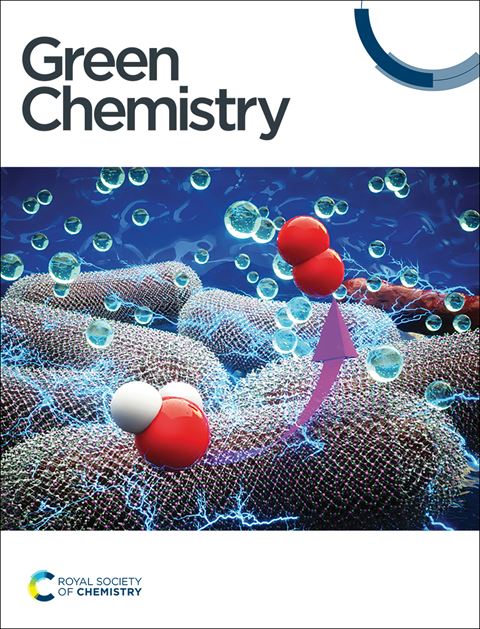Construction of a Cu3+–OH–Pt interface for enhancing glycerol electrooxidation coupled with hydrogen evolution†
IF 9.3
1区 化学
Q1 CHEMISTRY, MULTIDISCIPLINARY
引用次数: 0
Abstract
The electrochemical conversion of glycerol, a biodiesel byproduct, into formic acid coupled with the hydrogen evolution reaction (HER) offers a green route for biomass utilization. However, existing systems suffer from high energy demands and insufficient selectivity. Herein, a self-grown copper oxide nanorod catalyst decorated with platinum species (Pt/CuO NRs) is developed, reaching a current density of 20 mA cm−2 at 1.14 V vs. RHE, with 97.4% formic acid selectivity at 1.40 V vs. RHE and nearly 100% glycerol conversion. Electrochemical impedance spectroscopy and in situ Raman spectroscopy reveal that the introduction of Pt0 enhances electron transfer at the Cu3+–OH–Pt interface, facilitating CuIII–OOH formation. Density functional theory (DFT) analysis shows that Pt weakens the O–H bond strength in CuOOH and lowers the dehydrogenation energy barrier, synergistically boosting the glycerol oxidation reaction (GOR). Furthermore, a membrane electrode assembly (MEA) using Pt/CuO NRs as the anode and Pt/CuOx (c-Pt/CuOx) as the cathode is established for the GOR and HER, respectively, and it can operate at 1.55 V for a current density of 100 mA cm−2, reducing the potential by 380 mV compared to that required for water splitting. The developed GOR(+)||HER(−) electrolyzer demonstrates stable performance for 100 hours at 150 mA cm−2, with a formic acid selectivity of 90%. This represents a significant improvement over existing copper-based catalysts, highlighting the green chemistry advantages. Techno-economic analysis demonstrated the economic viability of electrochemically converting glycerol into potassium dicarboxylate (KDF) and H2, with processing costs of $4655–4797 per ton and a market value of $6389 per ton at representative commercial current densities of 100 and 300 mA cm−2.
Cu3+ -OH-Pt界面的构建促进甘油电氧化和析氢
将生物柴油副产物甘油电化学转化为甲酸,并结合析氢反应(HER),为生物质利用提供了一条绿色途径。然而,现有的系统存在能量需求高和选择性不足的问题。本文开发了一种以铂类修饰的自生长氧化铜纳米棒催化剂(Pt/CuO NRs),在1.14 V vs. RHE下电流密度达到20 mA cm - 2,在1.40 V vs. RHE下甲酸选择性为97.4%,甘油转化率接近100%。电化学阻抗谱和原位拉曼光谱显示,Pt0的引入增强了Cu3+ -OH-Pt界面的电子转移,促进了CuIII-OOH的形成。密度泛函理论(DFT)分析表明,Pt削弱了CuOOH中的O-H键强度,降低了脱氢能垒,协同促进了甘油氧化反应(GOR)的发生。此外,建立了以Pt/CuO NRs为阳极,Pt/CuOx (c-Pt/CuOx)为阴极的膜电极组件(MEA),分别用于GOR和HER,它可以在1.55 V下工作,电流密度为100 mA cm - 2,与水分解所需的电势相比降低了380 mV。所研制的GOR(+)||HER(−)电解槽在150 mA cm−2下可稳定运行100小时,甲酸选择性为90%。这代表了对现有铜基催化剂的重大改进,突出了绿色化学的优势。技术经济分析表明,电化学将甘油转化为二羧酸钾(KDF)和氢气的经济可行性,在代表性商业电流密度为100和300 mA cm - 2时,加工成本为每吨4655-4797美元,市场价值为每吨6389美元。
本文章由计算机程序翻译,如有差异,请以英文原文为准。
求助全文
约1分钟内获得全文
求助全文
来源期刊

Green Chemistry
化学-化学综合
CiteScore
16.10
自引率
7.10%
发文量
677
审稿时长
1.4 months
期刊介绍:
Green Chemistry is a journal that provides a unique forum for the publication of innovative research on the development of alternative green and sustainable technologies. The scope of Green Chemistry is based on the definition proposed by Anastas and Warner (Green Chemistry: Theory and Practice, P T Anastas and J C Warner, Oxford University Press, Oxford, 1998), which defines green chemistry as the utilisation of a set of principles that reduces or eliminates the use or generation of hazardous substances in the design, manufacture and application of chemical products. Green Chemistry aims to reduce the environmental impact of the chemical enterprise by developing a technology base that is inherently non-toxic to living things and the environment. The journal welcomes submissions on all aspects of research relating to this endeavor and publishes original and significant cutting-edge research that is likely to be of wide general appeal. For a work to be published, it must present a significant advance in green chemistry, including a comparison with existing methods and a demonstration of advantages over those methods.
 求助内容:
求助内容: 应助结果提醒方式:
应助结果提醒方式:


